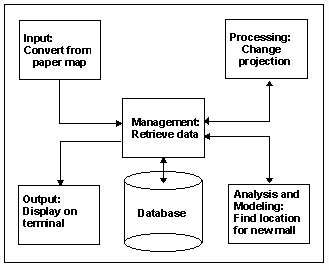![]()
Data Management: This module organizes data in the database and retrieves them from the database for use in other modules. It has the following subcomponents.
Organization: Data are organized to maximize efficiency and minimize storage space. A collection of related data collected with a purpose and serving a specific application is called a database. Geographic databases, particularly those of national coverages, are often very large. Hence the demand for efficient data storage on a GIS is particularly stringent.
Retrieval: Data are retrieved from the database for use in other operations. A retrieval is invoked by the user entering search conditions that could include spatial or non-spatial components. When we search for all properties for sale within one kilometre of a certain school, we are using a spatial condition "within one kilometre" and a non-spatial condition "properties for sale". Depending on the interface used, spatial conditions could be entered graphically. For instance, to specify the condition "within one kilometre", the user might be asked to draw a circle of one-kilometre radius over the display. Non-spatial conditions are entered as text or numbers.
Input and conversion: Data are converted to a digital form that can be stored and processed by computers. Some land surveying instruments record data in digital form. If we collect data from aerial photographs, satellite imageries, and existing maps, special equipment has to be used to convert analogue graphics to digital data. Data can also be imported from other systems, often requiring the help of a format converter to make it compatible with data in your system.
Processing: Data are updated, corrected, and modified to suit different applications. Common geographic processing includes scale changes, map projection changes, clipping, and cartographic enhancements.
Analysis and modeling: Analytical and statistical operations are performed on data to derive new information; present and future situations are modeled and simulated to support decision making. There is such a wide variety of geographic analysis and modeling functions that no GIS can yet support all of them. As a result, many of the more specialized functions must be custom-built into a GIS by the user.
Output: Results of the operations are displayed or exported to another system. Examples of output are graphic displays, text reports, and digital files. The examples below (shown from left to right) illustrate a graphic output on a terminal or paper, a text report, and a digital file.



Data: Data are a very important element because without them a GIS is like a car without fuel. The flow of data through the GIS software, with an example given for each module, is shown below.

![]()